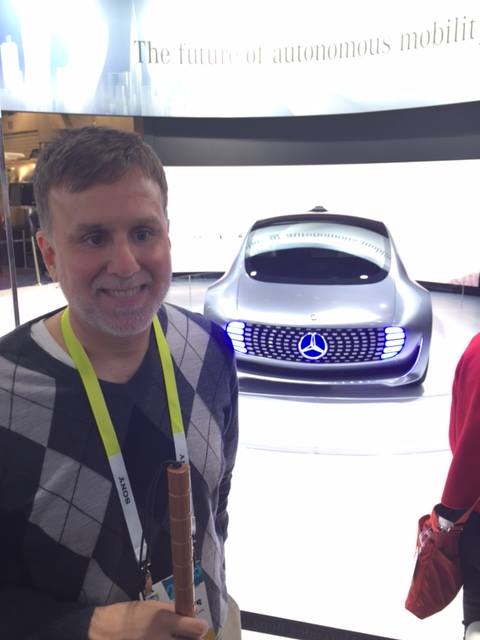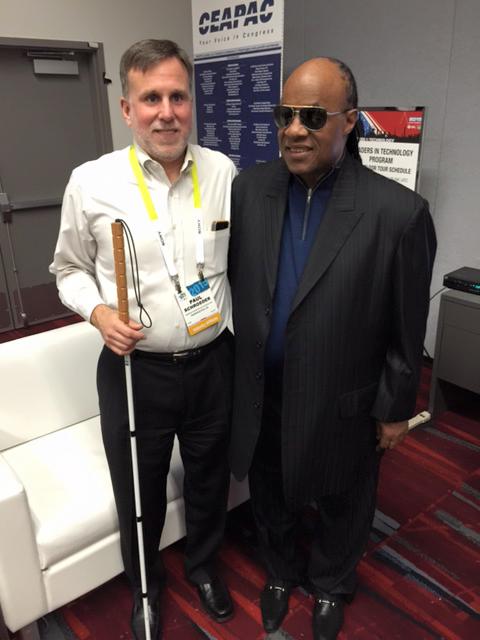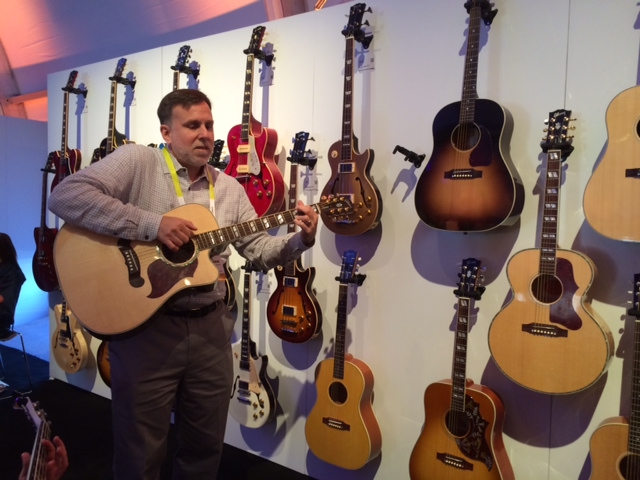
The Consumer Electronics Show (CES) took place earlier this month in Las Vegas with lots of gushing about the latest in huge televisions with remarkable pictures. Oddly, the show gave more and more attention to automotive technology. For those of us with vision loss, the other exciting trend was captured in an opening keynote by Boo-Keun Yoon, Samsung President and CEO, who described his company’s commitment to connecting all of its products via the Internet. By 2017, his goal is for 90 percent of Samsung devices to be connected via the Internet. This vision has come to be called the “Internet of Things” or IOT. Along with smartphones, Samsung produces home appliances, health and fitness gear, and much more. Already, people with vision loss have begun seeing the benefits of controlling smart thermostats, home security systems, and health monitoring devices using a smartphone. The promise of the IOT world for access is almost limitless. Of course, as we saw at CES, it's not clear that every piece of technology or clothing actually needs to be connected to the Internet.
William Reuschel, Manager of Technical Solutions, and I attended from AFB. We want to thank the Consumer Electronics Association (CEA) for making this visit possible and for their help in arranging meetings and interactions with leading industry players.
We had a chance to spend some time talking with Samsung about their phones, TVs, and even the new Samsung Galaxy Gear S (watch), which includes its own screen reader. Interestingly, the watch and television are built on the Tizen OS. During the quick overview of the accessible television, it appeared that Samsung has made some further improvement since we reviewed the Samsung UN50H6400 Television in AccessWorld last August.
If you’ve read any of the coverage of CES, you no doubt know that it is truly huge. For example, with more than 3600 exhibitors spread across multiple sites with over 2.2 million square feet of convention floor space. Every imaginable to category of consumer technology is well represented, and even hundreds of start-up companies attended. Still, it was surprisingly possible to get around Las Vegas to visit various exhibit sites and interact with a diverse array of companies.
Besides visiting some of the major technology companies like Samsung and Panasonic, William and I decided to focus on technologies to improve health, home, and fitness.
As noted earlier, the “Internet of Things,” offers us the prospect of controlling our appliances and home systems from a smartphone or tablet. Admittedly, this is only good for those who can afford the phone or tablet, but the prospects are tantalizing. Most of the major appliance companies and home system developers are connecting via mobile apps to the Internet. We visited Bosch and Whirlpool and also heard about developments at Samsung and LG. We also visited with Honeywell International. Of course, we weren't able to test the accessibility of any of their solutions so we hope to review some of the leading products in the future. For now, a limitation of the app-connected appliances is that they tend to be at the top of the price range and sometimes not available in the US market yet. But, chances are good that we’ll see more of these connected appliances.
To wrangle all of these “Internet of Things” devices, we learned about two competing standards that are being proposed. The Open Interconnect Consortium (OIC) includes members such as Samsung, Intel, and Cisco. This group is proposing a standard for communication of devices that belong to the IOT. This standard is competing with the group called the AllSeen Alliance which has a number of large stakeholders, and is a Linux Foundation collaborative project. Members of the AllSeen Alliance include Qualcomm, LG, Microsoft, Panasonic, and Sharp. Both of these organizations seek to create the communication protocol to facilitate communication between devices regardless of manufacturer, or how it talks to its “hub,” i.e., Ethernet, Bluetooth, or Zigbee. Organizations like the American Foundation for the Blind must work to ensure that these standards include the necessary features to support accessibility.
One interesting home product we did see was a smart electrical outlet developed by Brio. The idea behind this outlet replacement is that it uses microcontroller technology to prevent shocks. Brio’s outlets also connect to other sensors such as CO and smoke detectors.
With broad availability of various sensors and cheaper chips, electronic health devices are proliferating. Several hundred companies unveiled health-related devices and apps at CES. For an initial look at this fast-developing market, see the AccessWorld article on health and fitness products. It is nearly impossible to tell from a visit to an exhibit booth which products are promising, but the trend toward connected health devices is positive, if we are able to ensure that the apps work with Voiceover and Talkback. Of course, the actual device must also be operable by people with vision loss. One interesting technology that got a lot of attention, though we weren't able to see it, was the Bluetooth-equipped Pacif-i smart pacifier from Blue Maestro. It is a pacifier that serves as a thermometer and also a tracker in case your little one wanders away.
In the health space, companies are battling to be the platform on which health-related devices converge, making it convenient for consumers to keep all their health data in one easy to manage place and allowing communication with healthcare providers. Apple and Google are offering platforms, though neither exhibits at CES. Samsung and Qualcomm both described their approach to establishing the platform on which all this health device data and communications is managed. Qualcomm offers The 2net™ Platform* from Qualcomm Life. Samsung is offering its own S-Health platform. All of these solutions promise to aggregate health related data from third party devices for easy access for consumers.
It seemed like every exhibitor at CES had a fitness tracker device. Fitbit gained early attention in this space (see the August and November articles in AccessWorld), but lots of other companies now are hoping to measure your steps, heart rate and other vital health and fitness metrics. Withings, a French company that makes connected health devices, was there showing off its new fitness trackers, the Pulse Ox and Activit`e. The company invited us to take a look at the Pulse and so far, it’s a mixed bag, easy to set up with good Voiceover support, but some of the device functions like measuring heart rate cannot be performed without sight. And, the presentation of measurement results information in the iPhone app will need to be better organized.
Technology developers are starting to put fitness sensors into earbuds to monitor heart rate, blood oxygen, body temperature etc. from the ear canal. We had a chance to learn about “The Dash,” from the German company Bragi. These wireless smart in-ear headphones can store music, cancel or pass-through surrounding noise, and include a microphone for phone calls. If they work as advertised, your fitness information can also be provided verbally through the earbuds, giving you information about the distance you’ve gone, the speed you’re going and the impact on your heart rate etc. They’re taking pre-orders on this crowd funded technology for $299.00.
Audio technology remains a big part of CES. Although we weren't able to spend very much time checking out headphones and speakers, we did manage to indulge a love for good and interesting audio technology. Bone conduction Headphones have become popular among blind people since sound is delivered through vibrations to the cheek bones (in front of the ears), allowing the wearer to hear the surrounding ambient sounds. Aftershokz is a well-known developer of these headphones and while we were visiting their booth, we had a chance to visit with Ilkka Pirttimaa, the developer of BlindSquare. Aftershokz works closely with Blindsquare to increase access to information about getting around. Panasonic and a small company called Max Virtual LLC both showed off bone conduction headphones as well.
A new entrant, A-Audio showed off headphones combining style with quality. Audeze, another high-end headphone company, was showing off a product called the Subpac, a low frequency bass vibration pad you wear on your back. It provides the feeling of pounding bass delivered by a large woofer. And, the adorably named Acoustic Sheep, were back with improved SleepPhones® and RunPhones®, headphones incorporated into cloth headbands.
Speakers that use a table or other surface as the sounding board were also easy to find at CES. The “Bass Egg,” (which fits in your hand) was kicking up quite a bit of sound and will soon be able to attach to a window or wall as the sound surface.

In a “one on one” with Gary Shapiro, President and CEO of the CEA and Tom Wheeler, Federal Communications Commission Chair, lauded the Consumer Electronics Association and their Foundation for the commitment to accessibility. We echo his sentiment. He also noted that Internet connected technology offers great promise for people with disabilities, and he challenged the industry to ensure that accessibility isn’t an afterthought. It can’t be “down on the priority list,” he said.
The show indeed features all kinds of consumer technology, even Gibson Guitars sets up a booth. I got to indulge my love of all things guitar there by checking out some of the instruments on hand.
Finally, William and I heard about Mercedes autonomous (self-driving) vehicle. We weren’t able to sit inside its new “concept” car, which sounds like a mobile living room. Mercedes believes we might see self-driving cars in use by the year 2030. We say, bring it on!
